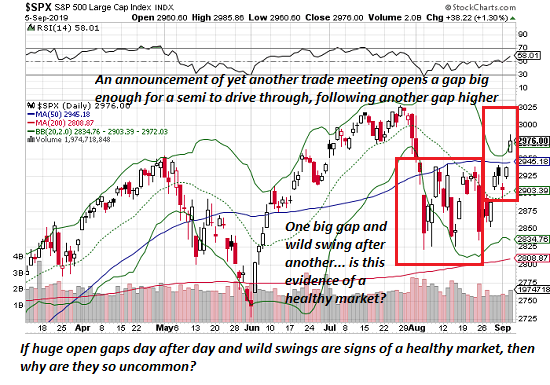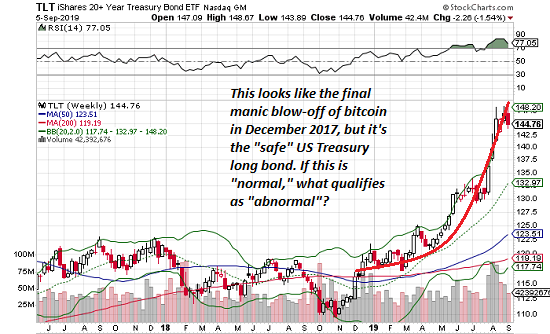Home » Posts tagged 'charles hugh-smith' (Page 3)
Tag Archives: charles hugh-smith
Economic Decay Leads to Social and Political Decay
Economic Decay Leads to Social and Political Decay
If we want to make real progress, we have to properly diagnose the structural sources of the rot that is spreading quickly into every nook and cranny of the society and culture.
It seems my rant yesterday (Let Me Know When It’s Over) upset a lot of people, many of whom felt I trivialized the differences between the parties and all the reforms that people believe will right wrongs and reduce suffering.
OK, I get it, there are differences, but if the “reform” doesn’t change the source of the suffering and injustice, it’s just window-dressing that makes the supporter feel virtuous. Want an example? Let’s take the the “cruel and unusual punishment” for drug-law offenders, many of whom are African-American males whose lives are effectively hobbled by felony convictions and long sentences in America’s Drug War Gulag.
You want a “reform” that actually gets to the root and solves the source of the injustice? It’s simple: decriminalize all drugs and recognize drug use as a medical and social issue rather than a criminal-justice / Gulag issue. But that won’t happen because too many people are making too much money off the Gulag, which is now a public and private-prison Gulag.(Other advanced nations have had success with this structural change. Maybe we could learn something from their examples?)
If you’re not ready to demand the full decriminalization of all drugs, then you’re not really interested in solving the problem; you’re just seeking virtue-signaling “reforms” that don’t upset the power structure. And since any real solution necessarily disrupts the power structure benefiting from the status quo, all the painless “reforms” are ineffective.
…click on the above link to read the rest of the article…
The Ultimate Heresy: Technology Can’t Fix What’s Broken
The Ultimate Heresy: Technology Can’t Fix What’s Broken
Technology can’t fix what’s broken, because what’s broken is our entire system..
The ultimate heresy in today’s world isn’t religious or political: it’s refusing to believe that technology can not only solve all our problems, it will do so painlessly and without any sacrifice. Anyone who dares to question this orthodoxy is instantly declared an anti-progress (gasp!) Luddite, i.e. a heretic in league with the Devil.
Even worse, if that’s possible, is declaring that technology is making our lives worse rather than better. There’s an entire industry devoted to cherry-picking data to support the One True Faith of Technology: a new miracle drug (never mind the side-effects or the fact that the drug only works on a relative handful of patients), a new energy source that will generate nearly free energy in near-infinite quantities (thorium reactors, though there is not yet a single one that’s operational), and the marketing of convenience: this new marketing gimmick will change your life–you can try on clothing in virtual reality, no need to go to the mall! Wow! Borrow more, buy more, throw more into the landfill–isn’t technology wonderful?
Meanwhile, back in reality, the previous “miracle drug,” statins, turn out to be useless in reducing heart disease and actively reduce health via a vast array of negative side effects: Do statins really work? Who benefits? Who has the power to cover up the side effects? (europeanscientist.com)
Heavily promoted “miracle drugs” make billions of dollars for the corporate owners, whether they actually improve health in the long-term or not. But the tech-will-fix-everything cheerleaders never get around to examining the spectacular failures of Big Pharma, or the catastrophic consequences of smartphone addiction (see chart below), or the impossibility of scaling technology without consuming vast amounts of resources which are already scarce.
…click on the above link to read the rest of the article…
Democracy Is Now a Hindrance to the Imperial State
Democracy Is Now a Hindrance to the Imperial State
Democracy is the coat of paint applied for PR purposes to the Imperial State.
If we step back from the histrionics of impeachment and indeed, the past four years of political circus, we have to wonder if America’s democracy is little more than an elaborate simulation, a counterfeit democracy that matches our counterfeit capitalism (Matt Stoller’s term).
If we review the mechanics of our “democracy,” we find that swapping which party controls Congress doesn’t really change the policies of The Imperial State, the central state that oversees America’s global commercial and geopolitical empire.Next, consider the high return rate of incumbents. Once in power, politicos can skim the millions of dollars in campaign contributions needed to win re-election.
Then there’s the some are more equal than others nature of the judicial system that serves the interests of financial and political elites: Bernie Madoff was free to continue his Ponzi scheme for years despite whistleblower attempts to instigate a federal investigation, and pedophile /schmoozer / “intelligence agency asset” Jeffrey Epstein was free to exploit underage teens and pile up $200 million after a wrist-slap conviction.
The corporate mass media is the PR machine for the Imperial State. If the state seeks to sell the public a war of choice, the media dutifully pounds the drums of war. If the Imperial State decides to disempower a president or other elected official, the media will hound the elected official until he/she is disgraced or buried, too busy fighting off the ceaseless media propaganda to function. The mass media excels at ruthlessly mocking political targets, reducing their stature in the public eye and undermining their “soft power.”
…click on the above link to read the rest of the article…
Financial Storm Clouds Gather
Financial Storm Clouds Gather
The price of this “solution”–the undermining of the financial system–will eventually be paid in full.
The financial storm clouds are gathering, and no, I’m not talking about impeachment or the Fed and repo troubles–I’m talking about much more serious structural issues, issues that cannot possibly be fixed within the existing financial system.
Yes, I’m talking about the cost structure of our society: earned income has stagnated while costs have soared, and households have filled the widening gap with debt they cannot afford to service once the long-delayed recession grabs the economy by the throat.
Everywhere we look, we find households, enterprises and local governments barely able to keep their heads above water–in the longest expansion in recent history. This is as good as it gets, and we’re only able to pay our bills by borrowing more, draining rainy-day funds or playing accounting tricks.
So what happens when earned income and tax revenues sag? Households, enterprises and local governments will be unable to pay their bills, and borrowing more will become difficult as the financial markets awaken to the re-emergence of risk: as shocking as it may be in the era of Central Bank Omnipotence, borrowers can still default and lenders can be destroyed by the resulting losses.
The era of Central Bank Omnipotence has been characterized by two things:
1. A disconnect between risk and return. Since “central banks have our backs,” risk has been vanquished, and since central banks socialize losses by bailing out corporations and banks who gambled and lost, then the financial Oligarchs have been free to ignore risk since the Federal Reserve has implicitly guaranteed returns will always be secured by Fed backstops, market interventions, etc.
…click on the above link to read the rest of the article…
The Black Swan Is a Drone
The Black Swan Is a Drone
What was “possible” yesterday is now a low-cost proven capability, and the consequences are far from predictable.
Predictably, the mainstream media is serving up heaping portions of reassurances that the drone attacks on Saudi oil facilities are no big deal and full production will resume shortly. The obvious goal is to placate global markets fearful of an energy disruption that could tip a precarious global economy into recession.
The real impact isn’t on short-term oil prices, it’s on asymmetric warfare: the coordinated drone attack on Saudi oil facilities is a Black Swan event that is reverberating around the world, awakening copycats and exposing the impossibility of defending against low-cost drones of the sort anyone can buy.(Some published estimates place the total cost of the 10 drones deployed in the strike at $15,000. Highly capable commercially available drones cost around $1,200 each.)
The attack’s success should be a wake-up call to everyone tasked with defending highly flammable critical infrastructure: there really isn’t any reliable defense against a coordinated drone attack, nor is there any reliable way to distinguish between an Amazon drone delivering a package and a drone delivering a bomb.
Whatever authentication protocol that could be required of drones in the future–an ID beacon or equivalent–can be spoofed. For example: bring down an authenticated drone (using nets, etc.), swap out the guidance and payload, and away it goes. Or steal authentication beacons from suppliers, or hack an authenticated drone in flight, land it, swap out the payload–the list of spoofing workaround options is extensive.
This is asymmetric warfare on a new scale: $20,000 of drones can wreak $20 million in damage and financial losses of $200 million–or $2 billion or $20 billion, if global markets are upended.If it’s impossible to defend against coordinated drone attacks, and impossible to differentiate “good” drones from “bad” drones, then the only reliable defense is to ban drones entirely from wide swaths of territory.
…click on the above link to read the rest of the article…
What a Relief that the U.S. and Global Economies Are Booming
What a Relief that the U.S. and Global Economies Are Booming
Doing more of what’s failed for ten years will finally fail spectacularly..It was a huge relief to see the charts of the Baltic Dry Index (BDI) and the U.S. retail sector ETF (RTH): both have soared to the moon, signaling that both the U.S. and global economies are booming: the BDI is widely regarded as a proxy for global shipping, which is a proxy for global trade and economic activity.
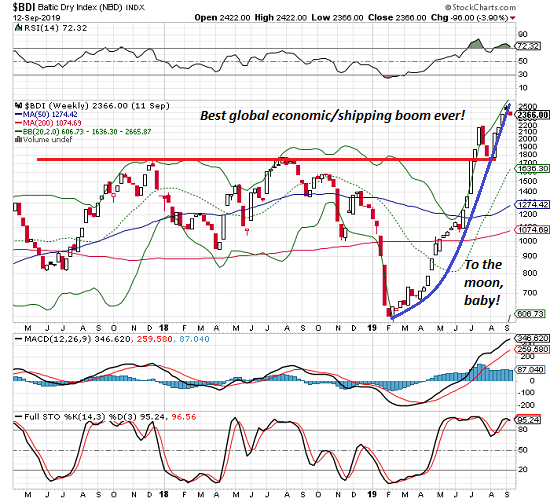
Amazon is 18% of the RTH basket of retail stocks, but the rest are conventional bricks and mortar chains with online sales: Walmart, Home Depot, Lowes, Costco, CVS, etc.The American consumer must be ready, willing and able to spend freely since the retail sector is hitting new heights.
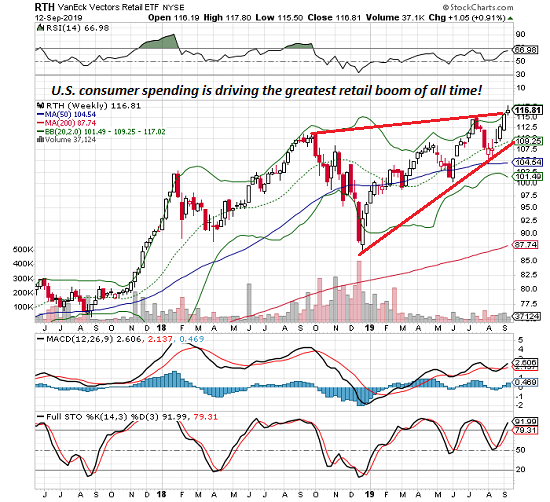
OK, now let’s change channels from soaring market valuations to the real-world economy. What planet are buyers of BDI and RTH on? Maybe the shipping and retail sectors are incredibly robust on Sirius B, but here on Planet Earth the global economy is weakening, trade is stagnating, shipping is in recession, and retail sales and profits are stagnating.
Lumping all American households in one basket gives a false signal of financial health. If we look at averages, debt levels are reasonable, incomes are notching higher and so expectations of rising household debt and spending are reasonable.
But this radically distorts reality: only the top 10% are creditworthy and have rising incomes; the bottom 90% are over-indebted, poor credit risks and their income is stagnant and/or precarious.
The top 10% of households–a mere 12 million households–are also precarious, as much of their wealth and income is based on insanely overvalued asset bubbles in stocks, bonds and real estate. The wealth effect fuels their free-spending ways (recall that the top 10% collect roughly half of all income and account for almost half of all consumer spending).
…click on the above link to read the rest of the article…
Will Everything Change in 2020-2025 or Will Nothing Change?
Any domino-like expanding crisis will unfold in a status quo lacking any coherent response.
Longtime readers know I’ve often referenced The Fourth Turning, the book that makes the case for an 80-year cycle of existential crisis in U.S. history.
The first crisis was the constitutional process (1781) following the end of the Revolutionary War, whether the states could agree on a federal structure; the 2nd crisis was the Civil War (1861) and the 3rd crisis was global war– World War II (1941).
According to this proposition, we’re fast approaching an existential crisis that could upend the status quo in a fundamental fashion.
While there is a great deal of historical evidence for cycles, predicting a major transition based on previous cycles is obviously a guess rather than a certainty.
So will everything change in 2020-25, or will the present simply extend another five years? We have to start by defining what qualifies as fundamental change. In my view, if the current distribution of income, power and ownership of capital remains unchanged, nothing of import has changed.
There might be dramas playing out in the political theater, but if the asymmetrical distribution of income, power and wealth doesn’t change, then the dramas are merely another form of distraction / entertainment.
The other type of change that qualifies as fundamental is the breakdown of the structures of everyday life: the distribution, cost and availability of food, fresh water, energy, healthcare, income and basic security.One way to measure the vulnerability of any society to breakdown or a fundamental reshuffling of income, wealth and power is to examine its buffers–the resiliency and reserves of the core systems.I often reference buffers, as these are largely invisible to everyone who isn’t intimately familiar with the workings of each system: the reserves that can be drawn upon in crisis, the redundancies, the staff and management training to handle crises, and so on.
…click on the above link to read the rest of the article…
The Fantasy of Central Bank “Growth” Is Finally Imploding
The Fantasy of Central Bank “Growth” Is Finally Imploding
Having destroyed discipline, central banks have no way out of the corner they’ve painted us into.
It was such a wonderful fantasy: just give a handful of bankers, financiers and corporations trillions of dollars at near-zero rates of interest, and this flood of credit and cash into the apex of the wealth-power pyramid would magically generate a new round of investments in productivity-improving infrastructure and equipment, which would trickle down to the masses in the form of higher wages, enabling the masses to borrow and spend more on consumption, powering the Nirvana of modern economics: a self-sustaining, self-reinforcing expansion of growth.
But alas, there is no self-sustaining, self-reinforcing expansion of growth; there are only massive, increasingly fragile asset bubbles, stagnant wages and a New Gilded Age as the handful of bankers, financiers and corporations that were handed unlimited nearly free money enriched themselves at the expense of everyone else.
Central banks’ near-zero interest rates and trillions in new credit destroyed discipline and price discovery, the bedrock of any economy, capitalist or socialist.
When credit is nearly free to borrow in unlimited quantities, there’s no need for discipline, and so a year of university costs $50,000 instead of $10,000, houses that should cost $200,000 now cost $1 million and a bridge that should have cost $100 million costs $500 million. Nobody can afford anything any more because the answer in the era of central bank “growth” is: just borrow more, it won’t cost you much because interest rates are so low.
And with capital (i.e. saved earnings) getting essentially zero yield thanks to central bank ZIRP and NIRP (zero or negative interest rate policies), then all the credit has poured into speculative assets, inflating unprecedented asset bubbles that will destroy much of the financial system when they finally pop, as all asset bubbles eventually do.
…click on the above link to read the rest of the article…
It’s Not Just the News That’s Fake–Everything’s Fake
It’s Not Just the News That’s Fake–Everything’s Fake
That we fall for the fakes and cons is understandable, given that’s all we have left in the public sphere.
What do we mean when we say corporate media is fake? We mean it’s a carefully crafted con, a set of narratives, cherry-picked data and heavily massaged statistics (the unemployment rate, etc.) designed to instill the reader’s confidence in a narrative that serves the interests not of the citizenry but of a select few pillaging the citizenry.
Once upon a time in America, no adult could survive without a finely tuned BS detector. Herman Melville masterfully captured America’s culture of cons and con artists in his 1857 classic The Confidence-Man, which I discussed in The Con in Confidence (October 4, 2006).
An essential component of the American ethos is: don’t be a chump. Don’t fall for the con. And if you do, it’s your own fault. America in 1857 was a simmering stew of con artists, flim-flammers and grifters exploiting the naive, the trusting and the credulous, and that remains the case in 2019.
We now inhabit a world where virtually everything is a con. That “organic” produce from some other country–did anyone test the soil the produce grew in? It could be loaded with heavy metals and be certified “organic” because no pesticides were used during production. Are there any nutrients left in the soil or has it been depleted? What’s in the water used to irrigate the crops?
The point of the con in offshored “organic” is the higher prices fetched. This is why it’s critical to ask of every narrative, story, product and data set: cui bono, to whose benefit?
…click on the above link to read the rest of the article…
The Planetary Insanity of Eternal Economic Growth
The Planetary Insanity of Eternal Economic Growth
This is the fantasy: we can rebuild our entire global industrial society every generation or two forever.
“Earthrise” is one of the most influential photographs ever published. Taken on the Apollo 8 mission in late December 1968 by astronaut Bill Anders, it captures Earth’s uniqueness, isolation and modest scale: a blue and white dot on a vast sea of lifeless darkness.
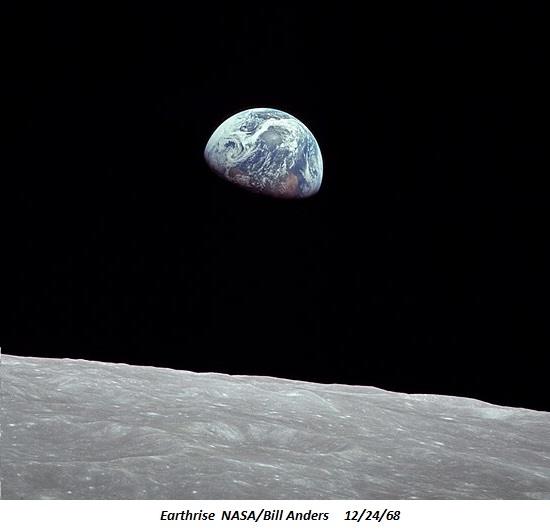
The revelation that strikes me is the insanity of pursuing eternal economic growth, not as an option but as the only possible path: there is literally no alternative to extracting ever greater quantities of the planet’s resources to enable ever greater consumption by the planet’s 7.7 billion humans.
Stripped to its essence, this mad drive is about profit and power. The necessity is sold as the only path to prosperity for humanity, but it’s really about securing wealth and power for the few.
A recent article in Scientific American magazine highlights how the idealistic impulses of protecting the planet’s diverse life from the machinery of “growth” are inevitably subsumed by the necessity for profit: The Ecologists and the Mine.
Here’s what these kinds of articles never say: markets cannot price in the value of non-monetized natural assets such as diverse ecosystems. Whatever cannot be monetized right now is worthless, as markets lack any mechanism to price in what cannot be valued by market supply and demand in the moment.
There is no way to fix this fatal flaw in markets, and attempts to do so are merely excuses deployed to enable the profitable exploitation and resulting ruin.
(Recall that neoliberalism is the quasi-religious ideology of turning everything on Earth into a market, so it can be exploited and financialized by the few at the expense of the many.)
…click on the above link to read the rest of the article…
Following in Rome’s Footsteps: Moral Decay, Rising Inequality
Following in Rome’s Footsteps: Moral Decay, Rising Inequality
Here is the moral decay of America’s ruling elites boiled down to a single word.
There are many reasons why Imperial Rome declined, but two primary causes that get relatively little attention are moral decay and soaring wealth inequality. The two are of course intimately connected: once the morals of the ruling Elites degrade, what’s mine is mine and what’s yours is mine, too.
I’ve previously covered two other key characteristics of an empire in terminal decline: complacency and intellectual sclerosis, what I have termed a failure of imagination.
Michael Grant described these causes of decline in his excellent account The Fall of the Roman Empire, a short book I have been recommending since 2009:There was no room at all, in these ways of thinking, for the novel, apocalyptic situation which had now arisen, a situation which needed solutions as radical as itself. (The Status Quo) attitude is a complacent acceptance of things as they are, without a single new idea.
This acceptance was accompanied by greatly excessive optimism about the present and future. Even when the end was only sixty years away, and the Empire was already crumbling fast, Rutilius continued to address the spirit of Rome with the same supreme assurance.
This blind adherence to the ideas of the past ranks high among the principal causes of the downfall of Rome. If you were sufficiently lulled by these traditional fictions, there was no call to take any practical first-aid measures at all.
A lengthier book by Adrian Goldsworthy How Rome Fell: Death of a Superpower addresses the same issues from a slightly different perspective.
Glenn Stehle, commenting on a thread in the excellent website peakoilbarrel.com (operated by the estimable Ron Patterson) made a number of excellent points that I am taking the liberty of excerpting: (with thanks to correspondent Paul S.)
…click on the above link to read the rest of the article…
Dear Central Bankers: Prepare to be Swept Away in the Next Wave of Populism
Dear Central Bankers: Prepare to be Swept Away in the Next Wave of Populism
The political moment when the “losers” connect their discontent and decline with central bankers is approaching.
The Ruling Elites’ Chattering Classes still haven’t absorbed the key lesson of the 2016 U.S. presidential election: the percentage of the populace that’s becoming wealthier and more financially secure in the bloated, corrupt, self-serving Imperial status quo is declining and the percentage of the populace that’s increasingly insecure and financially precarious is increasing, and candidates that mouth the usual platitudes in support of the bloated, corrupt, self-serving Imperial status quo lose to those who speak of the failing status quo as a travesty of a mockery of a sham, i.e. a “populist” speaking truth to power.
Donald Trump steered clear of the status quo’s favored platitudes and embraced a bit of populist cant, and so to those who understand that the majority of Americans have been abandoned by America’s hubris-soaked, self-serving managerial / ruling elites, his victory was not entirely surprising.
Just as we’ve reached Peak hubris-soaked, self-serving managerial / ruling Elites, we’ve also reached Peak Central Bank Cargo Cult: from now on the majority that’s been abandoned by the managerial / ruling elites will become increasingly aware that the unprecedented asymmetries of wealth and power that have undermined American social and economic life can be traced directly back to the central bank, the Federal Reserve, which has become the all-powerful Cargo Cult of the global economy.
The same awareness of central bankers’ responsibility for soaring wealth-income inequality and the decline of social mobility is spreading in other nations as well.
…click on the above link to read the rest of the article…
The Self-Destructive Trajectory of Overly Successful Empires
The Self-Destructive Trajectory of Overly Successful Empires
It’s difficult not to see signs of this same trajectory in the U.S. since the fall of the Soviet Empire in 1990.A recent comment by my friend and colleague Davefairtex on the Roman Empire’s self-destructive civil wars that precipitated the Western Empire’s decline and fall made me rethink what I’ve learned about the Roman Empire in the past few years of reading.
Dave’s comment (my paraphrase) described the amazement of neighboring nations that Rome would squander its strength on needless, inconclusive, self-inflicted civil conflicts over which political faction would gain control of the Imperial central state.
It was a sea change in Roman history. Before the age of endless political in-fighting, it was incomprehensible that Roman armies would be mustered to fight other Roman armies over Imperial politics. The waste of Roman strength, purpose, unity and resources was monumental. Not even Rome could sustain the enormous drain of civil wars and maintain widespread prosperity and enough military power to suppress military incursions by neighbors.
I now see a very obvious trajectory that I think applies to all empires that have been too successful, that is, empires which have defeated all rivals or have reached such dominance they have no real competitors.Once there are no truly dangerous rivals to threaten the Imperial hegemony and prosperity, the ambitions of insiders turn from glory gained on the battlefield by defeating fearsome rivals to gaining an equivalently undisputed power over the imperial political system.
The empire’s very success in eliminating threats and rivals dissolves the primary source of political unity: with no credible external threat, insiders are free to devote their energies and resources to destroying political rivals.It’s difficult not to see signs of this same trajectory in the U.S. since the fall of the Soviet Empire in 1990.
…click on the above link to read the rest of the article…


